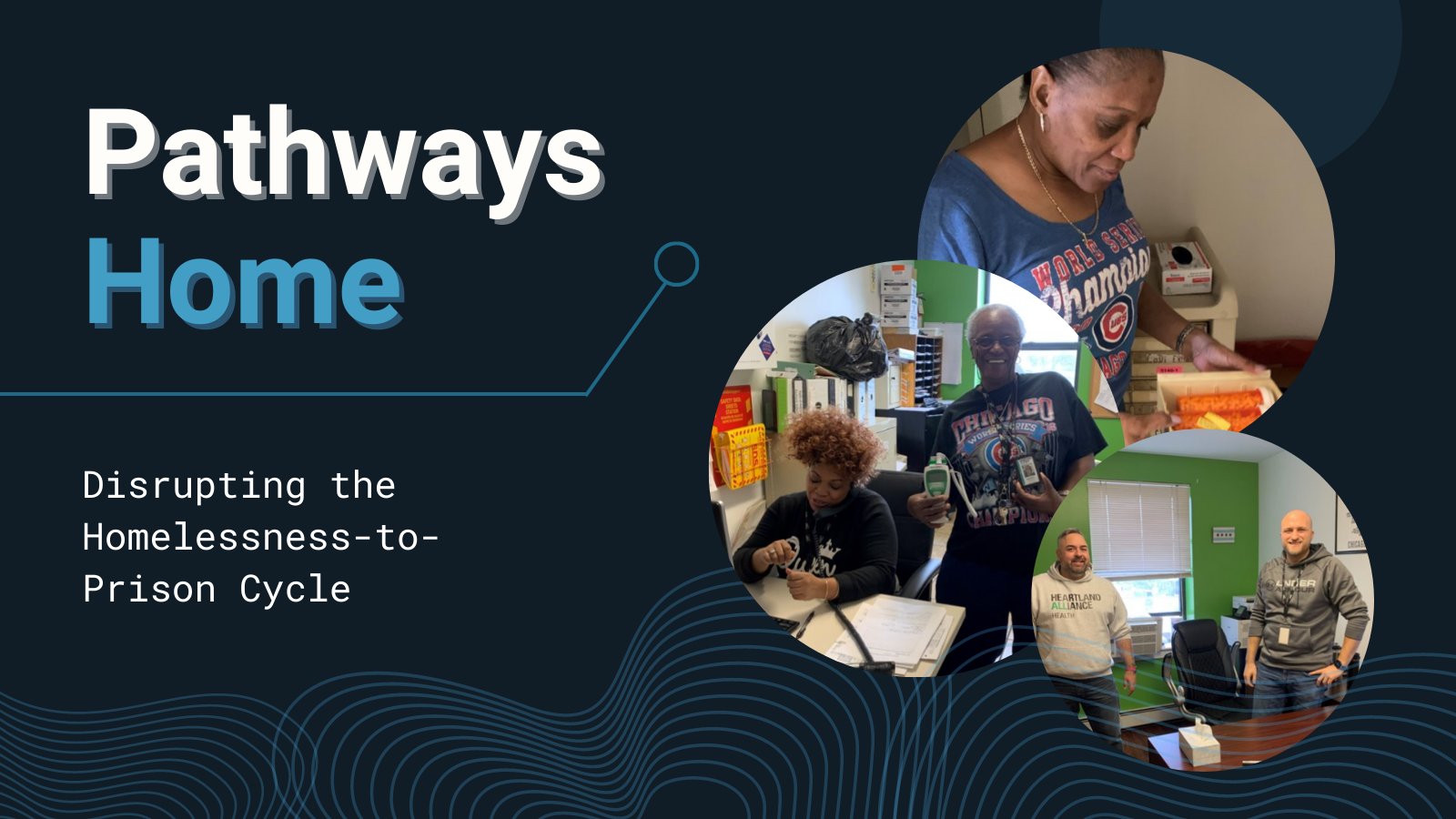Many individuals experiencing homelessness have a history of incarceration or criminal justice system involvement, and homelessness itself leaves people at an elevated risk of further justice involvement. At Heartland Alliance Health (HAH), breaking this vicious cycle by providing healthcare to people experiencing homelessness is a core mission. At HAH, a Federally Qualified Health Center, a deeply relational approach informs everything they do in engaging and serving Chicago’s unhoused population, including the operation of their housing program, Pathways Home. The approach of traditional housing models is often paternalistic; individuals receiving services frequently feel that decisions are made for them rather than by or with them. In contrast, Pathways Home levels the care dynamic, employing a relational pivot for effective clinical intervention that results in sustained engagement.
“We meet people where they are,” says HAH Executive Director Ed Stellon. “We support them in making the best decision they are ready, willing, and able to make that day.” Working with people who have been placed “in the passenger seat” by conventional service systems, Heartland’s approach instead puts them behind the wheel with strong support founded on harm reduction principles.
Pathways Home: A Program Focused on Harm Reduction
Pathways Home engages the most vulnerable people experiencing homelessness in Chicago, working with them to get and keep them housed while allowing the individuals to move toward recovery and addiction treatment at their own pace. Those who qualify for the program can move into an apartment in an environment with integrated services where they have a lease for as long as they need to be there. The Pathways program fills 2 floors of a 6-story building in Chicago, with the capacity to house 50 people.
To be housed through Pathways Home, an individual must meet the Category 1 HUD definition of literal homelessness [PDF], which, according to Stellon, is “the strictest” of the many ways [PDF] homelessness is defined. They must be on the street or in a shelter, and in order to be eligible, they must also have a diagnosis of mental illness along with a substance use disorder. If a person is actively in recovery, they are placed with a housing provider offering less intensive supportive services.
Stellon describes Pathways Home as a “service-rich, ‘high touch’” environment. Staff help with activities of daily living and more. They can support the individuals receiving their services by going to court with them, going grocery shopping, meeting with family, and generally providing overall support in making smart decisions through compassionate inquiry and a harm reduction approach. “Harm reduction is in our DNA,” Stellon explains. “It is infused in everything we do.”
Contrary to the cultural myth that harm reduction means “anything goes,” Stellon describes harm reduction as “a person-centered approach that challenges us to look at the world through the eyes of the person we’re talking to.” Harm reduction is collaborative and involves assisting an individual in making the best decision they can at the time, resulting in movement toward a good or better outcome.
The Nexus Between Incarceration and Homelessness
Mr. Stellon estimates—conservatively—that of the 11,000 people Heartland serves in the Chicago area, more than 75 percent have a history of involvement with the justice system. According to the National Low Income Housing Coalition, people who have been incarcerated at some point are more than 10 times more likely to experience homelessness than those who have not. Often this system involvement reflects “crimes of survival” related to poverty and homelessness, both of which are social determinants of health linked with higher rates of trauma and mental and substance use disorders.[1] People may then be traumatized, or retraumatized, in prison or jail and then summarily released with no place to go. “Our criminal justice system is not a trauma-informed system,” Stellon notes.
When assessing people for the Pathways Home program, Heartland puts those who were incarcerated at “high risk” on the vulnerability index [PDF], a tool used throughout Chicago’s coordinated entry system to determine service needs. In Chicago, like other cities, individuals must go through a single point of entry to receive housing programming; a history of involvement in the justice system is noted as a vulnerability that contributes to prioritization, helping individuals with past justice involvement more readily access key housing interventions.
The Social Impact of Supportive Housing
According to Stellon—and as supported by substantial data from the Corporation for Supportive Housing—programs like Pathways Home have ripple effects. The individual who receives supportive housing with embedded services benefits at the outset, but the potential systemic impacts are wide and deep. Programs like Pathways Home create benefits that reverberate through systems and agencies by relieving the stress on the criminal justice system (which would otherwise be processing more infractions of laws that criminalize homelessness and related crimes of survival) and helping overtaxed emergency rooms by providing security and ongoing support to people experiencing homelessness who suffer physical and mental illnesses. According to Stellon, when a program like Pathways Home addresses social determinants of health like stable housing and supportive services, Medicaid can save tremendous money.
Individuals in Pathways Home benefit by being a part of a community that cares. A participant who has lived at the program since 2017 says, “Pathways has kept me off the street and keeps me warm and fed. . . . They make sure I see my doctors by keeping up with my appointments. I like to keep busy by helping [staff] in the kitchen for breakfast and to help [staff] with food deliveries.”
Stellon notes that many people who have been incarcerated “find some solace in a little bit of structure” and are more amenable to following community-related rules. They realize “we’re in this together,” and there must be some rules and expectations in a housing complex. But many have endured system-related trauma in addition to adverse childhood events, resulting in a common negative outcome of institutional involvement: a lack of trust, especially in authority. Pathways Home staff must earn trust slowly and carefully to support an individual’s agency and willingness to change. They do this by reflecting the core value of harm reduction in every step they take.
This core value informs everything from daily interactions to how the organization reacts to broad shifts in behavioral health risk. For example, when fentanyl overdose began impacting the people they serve, harm reduction defined their response. Michael Mallory, senior director of clinical operations, describes his team’s approach to reducing overdose risk, saying, “Ultimately, the way that we are able to intervene is through the regular wellness checks that were implemented under my direction in 2017. . . . Since then, we have maintained wellness checks at the start and end of every shift. Additionally, we have encouraged [people with high-risk use habits] to let us know if and when they are contemplating use, and we will conduct 15-minute interval wellness checks.”
According to Stellon, authentic relationship-building is the key to working with individuals reentering the community after incarceration. With a population where “almost everyone has a correctional history,” this work is slow and steady. “We find a lot of folks come out (of incarceration) with trauma,” Stellon says, “and we work hard to gain their trust.” Pathways Home provides a way to heal that trauma and allow returning citizens to be part of a supportive community.
[1] Joel A. Dvoskin, James L. Knoll, and Mollie Silva, “A Brief History of the Criminalization of Mental Illness,” CNS Spectrums 25, no. 5 (October 2020): 638–50,



